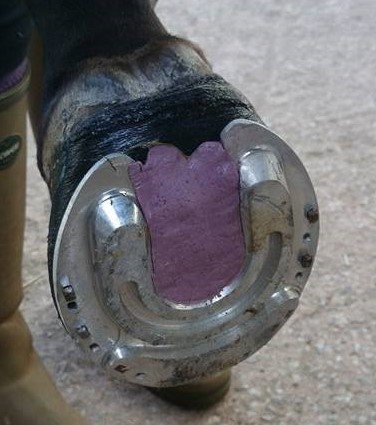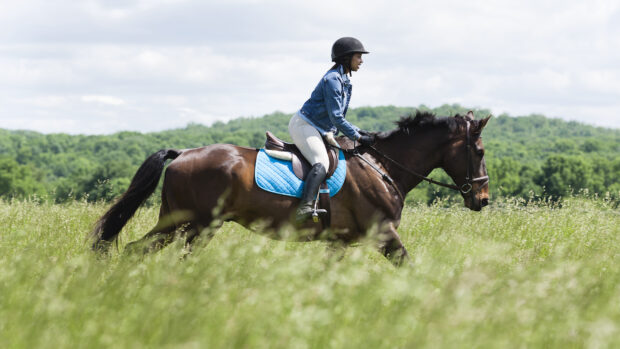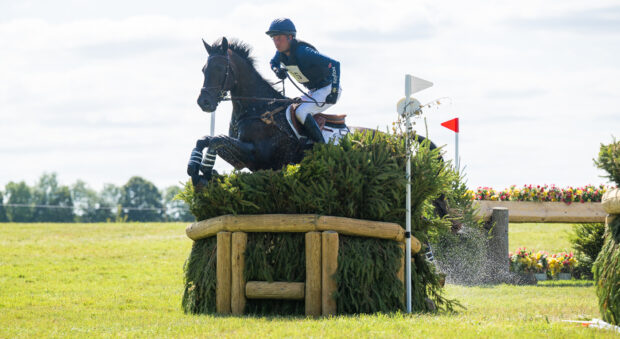The last couple of weeks have been great. I’ve had the opportunity to take part in some really fascinating PhD research being carried out by Jenni Douglas, who is subject manager within Hartpury’s higher education equine department.
Essentially, Jenni has been looking at the cardiorespiratory and neuromuscular responses of the human body to horse riding. To do this, she has put volunteer subjects through their paces by way of a treadmill exercise test in our human performance lab and also via assessment on a horse. By testing in this way, Jenni will establish how best to train riders to improve their fitness, endurance and stability on a horse.
I did my treadmill test last week, during which I was hooked up to a heart rate monitor, and had to breathe into a pipe to measure oxygen uptake. At least all my huffing and puffing while running wasn’t in vain!
The equipment allowed Jenni to determine VO2max, which is the maximal amount of O2 (oxygen) a person can use during exercise. My VO2max was 47ml/kg/min, which means that for every kilo of my bodyweight, I can use 47ml of oxygen per minute at my current fitness level. The idea is that you train to increase this figure. When you consider an elite cyclist will be somewhere around the 75ml/kg/min mark, I’m not quite there yet!
This data was combined with heart rate readings, measurement of blood lactate and a subjective self-assessment of how hard I felt I was working at any given time.
I go to the gym a few times a week, but didn’t really know how fit I was – it was amazing to have all this kit to play with and give a better idea of where my fitness is. However, there is no way to look glamourous while you’re doing this kind of thing as this picture proves!

We did part two of the study this week, which was similar in that there was a set exercise test to complete, but this time on a horse.
It was made up of timed periods of sitting trot, rising trot, canter sitting and in half-seat and then popping a small fence a few times. It was very odd riding in a Darth Vader-style mask to begin with (again to measure O2 uptake), but thankfully my borrowed steed didn’t seem too phased by the whole thing.
This week’s test also included the use of EMG sensors, which measure muscle activity, and a heart rate monitor for comparative data that we collected from the running bit. There was a lesson happening while we were doing all this and I think we gave Jane, the instructor, and her students a bit of a shock as I cantered towards them in all my get up! All I needed was a cape and a black helmet and I’d have had the Darth Vader look all sewn up….
I can’t wait for Jenni to bring together all of her results; she has tested over 100 riders and so it will be awesome to see what she comes up with. Research of this kind of thing brings us closer to establishing just what we should be doing off the horse to help us become better riders, and is another step closer to dispelling the age-old belief that riders don’t count as athletes.
Dancing Shoes
I’ve talked about shoeing fairly often in the past, I guess because it’s such an important factor in successful rehabilitation.
Our farriers at Hartpury are not averse to utilising some of the more unusual varieties of equine footwear available to them should the need arise.

Pictured is a “Rock n’ Roll” shoe on a horse shod for us by Kelvin Lymer of Sandpitt Forge. He used a pair of these amazing-looking creations in front, coupled with a pair of “fish-tails” behind. Fish tails have curved, extended length on the back of the shoe to give added heel support.
Arguably, Rock n’ Roll horseshoes are used in Europe more often than here. They were sported by the Spanish dressage horse Fuego de Cardenas at the 2012 London Olympics.
The structure of the shoe allows the horse to move around the centre of rotation. In this instance the shoe has been nailed into a cast applied around the hoof wall. The cast is made of the same stuff that is used for people with a broken leg or arm. The cast is used because of poor hoof horn quality, in this case providing a more rigid receptor for the nails to keep the shoe on. It is finished off with a 30-sure hoof pack (which is a purple, putty-like material), compressed into the central cavity of each shoe, providing a central support to the whole foot.
I personally have never seen anything like it, but what an amazing job the whole composition does. The horse loads his foot evenly on landing, preventing any imbalance in weight distribution throughout the foot. I can only say, Kelvin — you are a genius!
Fizz





